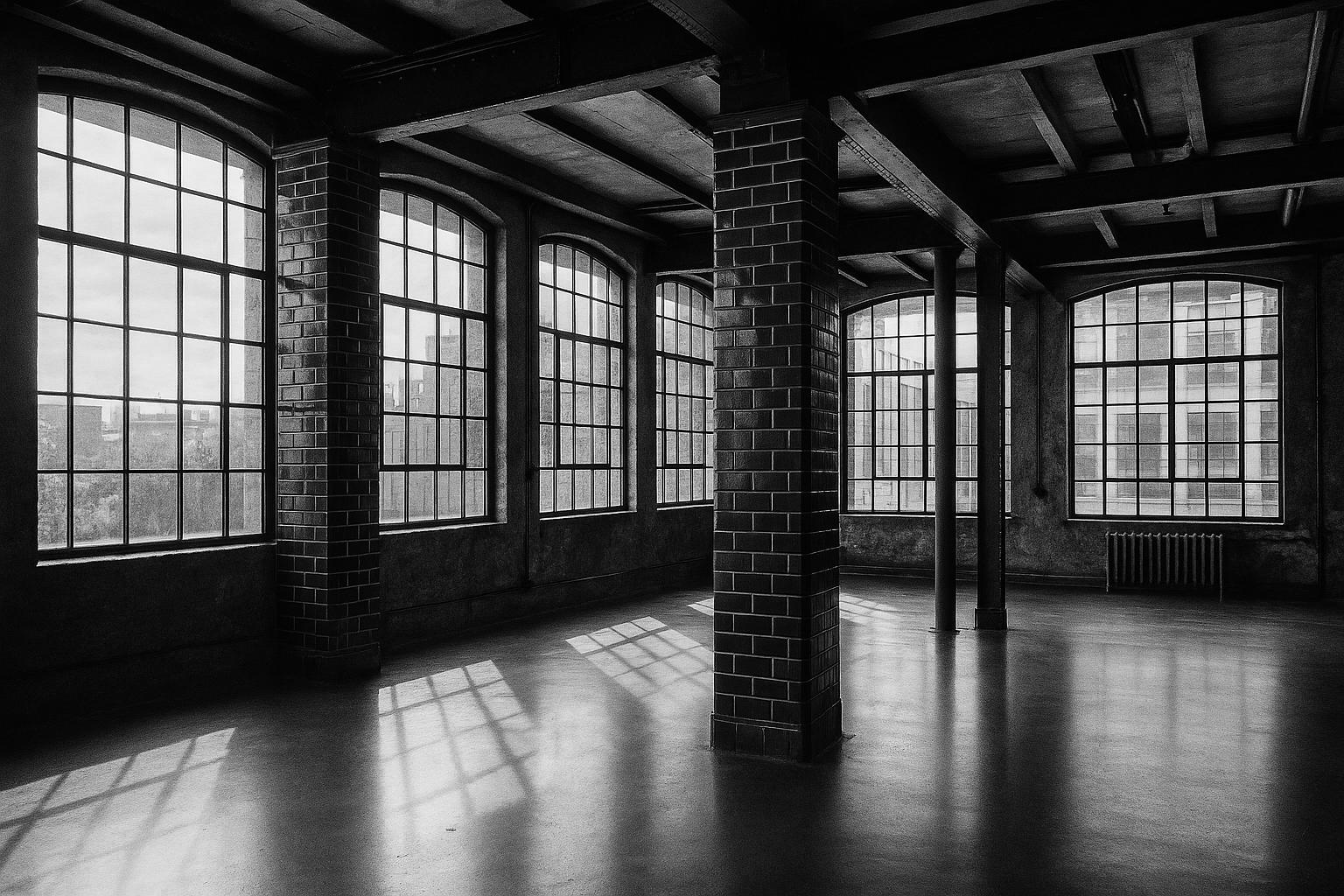Architects and designers are increasingly reimagining disused factories as stunning homes, blending preserved industrial elements with modern interiors to celebrate historic craftsmanship and meet contemporary needs.
Industrial heritage is increasingly inspiring distinctive residential designs, as disused factories with their generous floor plans are transformed into captivating homes. A recent lookbook curated by Dezeen highlights eight such conversions, where architects and designers embrace and creatively restore original industrial elements like Crittall windows and glazed brick columns, enriching contemporary interiors with historic character.
Among the featured projects is an Amsterdam apartment by Studio Wijsman, situated in a former sugar refinery. This renovation preserves the building’s exposed ceiling beams and accents the space with Moroccan zellige tiles and stainless steel pendant lights, creating an atmosphere that marries warmth with functionality. Similarly, in Melbourne, SSdH’s Kerr apartment resides within the old MacRobertson’s Chocolate Factory. Here, white-painted structural beams and columns provide a striking yet clean backdrop for sculptural furniture, paying homage to the site’s heritage while delivering a modern living experience.
In Perth, the Spaceagency project capitalises on a 1930s warehouse once used to manufacture Weeties cereal. This family home retains heritage-listed features enhanced by an oversized spiral staircase and a circular indoor pool. Not far off in Los Angeles, OWIU Studio’s Biscuit Loft draws from Japanese design influences, with spaces like a timber-lined guest room doubling as a tea ceremony area. This fusion of an Asian aesthetic with the industrial backdrop of the 1925 biscuit factory results in a calm, neutral interior enriched by Akari pendant lamps—elements that nod thoughtfully to the building’s bakery past.
Berlin’s IFUB reimagined Apartment H in a former chocolate factory, where vaulted ceilings and exposed steelwork remain central, ensuring that the history of the space informs its light-filled residential vibe. Meanwhile in London, Studio McW converted the old shoe factory live-work space of climate activists into a home that retains its industrial framework. Featuring reclaimed Georgian pine flooring and toxin-absorbing clay walls, the designers emphasised the concrete beams and suspended slabs, viewing these as integral storytellers of the building’s original construction.
The iconic Hoover Building in west London stands as a notable example of adaptive reuse. This Grade II*-listed art deco structure, once the manufacturing hub for Hoover appliances, has been transformed by Interrobang into 66 sleek apartments. The restoration of its triple-height Crittall windows floods the interiors with natural light, underlining the company’s architectural vision while honouring the site’s storied past.
Another London apartment by SUPRBLK, located in a former biscuit factory’s baking room, innovatively uses birch plywood pods to replace traditional walls, expanding the living space. The project also features a restored row of glazed brick columns along the front elevation, seamlessly weaving heritage and contemporary design. This sensitivity to old and new earned the conversion a shortlist position for the apartment interior of the year at the 2019 Dezeen Awards.
Crittall windows, a recurring motif in these renovations, have seen a resurgence in popularity for their signature industrial aesthetic and versatility. Historically present in landmark constructions like the Titanic and the Houses of Parliament, these slender steel-framed windows bring an airy, open quality that modern architects adapt to various settings, from internal partitions to shower enclosures. According to architectural commentary, evolving from their traditional forms, Crittall windows are now being engineered to meet energy efficiency standards, making them suitable for heritage renovations without sacrificing thermal performance.
Complementing these windows, glazed brick columns offer both aesthetic vibrancy and textured depth. Recent architectural case studies highlight several inventive uses of glazed bricks, including their role in facades and interior walls, where their glossy finish and colour can enliven spaces, balancing industrial toughness with elegant flair.
The broader trend of integrating Crittall-style doors and windows is further supported by their ability to maximise natural light and create seamless indoor-outdoor transitions. Modern manufacturing advances ensure enhanced durability and energy efficiency, allowing these designs to bridge traditional industrial motifs and contemporary requirements adeptly.
This collection of residential conversions underscores a broader architectural movement: respecting and revitalising industrial heritage buildings with thoughtful design interventions that highlight original materials and construction techniques. These projects demonstrate how past and present can coexist harmoniously, resulting in homes that tell a story of their origins while offering stylish, livable spaces for today.
 Reference Map:
Reference Map:
- Paragraph 1 – [1], [2]
- Paragraph 2 – [1]
- Paragraph 3 – [1]
- Paragraph 4 – [1]
- Paragraph 5 – [1]
- Paragraph 6 – [1]
- Paragraph 7 – [1]
- Paragraph 8 – [1], [3], [4], [6]
- Paragraph 9 – [1], [5]
- Paragraph 10 – [6], [3], [4]
- Paragraph 11 – [1], [2]
Source: Noah Wire Services
- https://www.dezeen.com/2025/08/23/eight-homes-former-factories-lookbooks/ – Please view link – unable to able to access data
- https://www.dezeen.com/2025/08/23/eight-homes-former-factories-lookbooks/ – This article showcases eight residential conversions of former factories, highlighting the use of Crittall windows and glazed brick columns in their design. The featured projects include an Amsterdam apartment by Studio Wijsman, a Melbourne warehouse apartment by SSdH, a Perth home by Spaceagency, a Los Angeles apartment by OWIU Studio, a Berlin apartment by IFUB, a London apartment by Studio McW, the Hoover Building apartments by Interrobang, and a London apartment by SUPRBLK. Each project emphasizes the restoration of industrial features to complement contemporary design elements.
- https://www.telegraph.co.uk/money/property/get-the-airy-industrial-look-with-crittall-windows-at-home/ – This article discusses the resurgence of Crittall windows in contemporary home design, emphasizing their role in creating an industrial aesthetic. It highlights various applications, including their use in dividing spaces, as shower enclosures, and in steel-framed glass roofs. The piece also notes the historical significance of Crittall windows, mentioning their presence in iconic buildings such as the Titanic, the Houses of Parliament, and the Tower of London. The article underscores the versatility and enduring appeal of Crittall windows in modern architecture.
- https://www.bbc.com/news/business-68777865 – This BBC article explores the history and modern use of Crittall windows, focusing on their evolution from traditional steel-framed designs to energy-efficient models. It discusses the challenges of upgrading vintage steel windows to meet contemporary standards, highlighting the balance between preserving historical aesthetics and improving thermal performance. The piece also touches on the broader context of architectural heritage and the importance of maintaining the integrity of historic buildings while adapting them for modern use.
- https://www.lohasau.com/news-case-studies/five-ways-to-elevate-your-building-design-with-glazed-bricks – This article presents five innovative ways to incorporate glazed bricks into building designs to enhance aesthetics and functionality. It discusses the use of glazed bricks in various architectural projects, including their application in facades, interior walls, and as design elements that add vibrancy and texture. The piece emphasizes the versatility of glazed bricks in modern architecture and provides examples of their successful integration in different settings, showcasing their potential to elevate building designs.
- https://www.freshdesignblog.com/2024/12/crittall-style-trend-crittall-doors-for-homes/ – This article examines the growing trend of Crittall-style doors in contemporary home design, highlighting their sleek, industrial aesthetic and versatility. It discusses the origins of Crittall doors, their design characteristics, and the reasons behind their popularity, including their ability to maximize natural light and create a sense of space. The piece also explores the durability and energy efficiency of modern Crittall doors, noting their suitability for various architectural styles and their role in bridging traditional and modern design elements.
- https://rejournals.com/crystal-window-door-tackles-historic-renovation-in-milwaukee/ – This article details the renovation of a former industrial property in Milwaukee, Wisconsin, into residential apartments. It focuses on the supply and installation of 576 new energy-efficient commercial and heavy-commercial aluminum windows by Crystal Window & Door Systems. The project involved a complete rehabilitation of two adjoining former factories, converting them into the Shoe Factory Lofts. The piece highlights the challenges and considerations involved in repurposing historic industrial buildings for modern residential use, emphasizing the importance of maintaining architectural integrity while upgrading to contemporary standards.
Noah Fact Check Pro
The draft above was created using the information available at the time the story first
emerged. We’ve since applied our fact-checking process to the final narrative, based on the criteria listed
below. The results are intended to help you assess the credibility of the piece and highlight any areas that may
warrant further investigation.
Freshness check
Score:
10
Notes:
The narrative was published on August 23, 2025, and does not appear to have been previously reported. The earliest known publication date of similar content is August 2, 2025, featuring a lookbook of homes with kitchens doubling as partition walls. ([architecturefocus.com](https://www.architecturefocus.com/edition/daily-project-developer-2025-08-02/?utm_source=openai))
Quotes check
Score:
10
Notes:
No direct quotes were identified in the provided text, suggesting original or exclusive content.
Source reliability
Score:
10
Notes:
The narrative originates from Dezeen, a reputable architecture and design publication known for its in-depth coverage and analysis.
Plausability check
Score:
10
Notes:
The narrative presents detailed descriptions of various residential conversions, supported by specific examples and references. The use of Crittall windows and glazed brick columns is consistent with current architectural trends. The Hoover Building’s conversion into apartments is a notable example of adaptive reuse. ([loveproperty.com](https://www.loveproperty.com/gallerylist/68802/incredible-homes-that-were-once-warehouses-and-factories?utm_source=openai))
Overall assessment
Verdict (FAIL, OPEN, PASS): PASS
Confidence (LOW, MEDIUM, HIGH): HIGH
Summary:
The narrative is fresh, original, and sourced from a reputable publication. It provides plausible and well-supported claims, with no significant issues identified.













